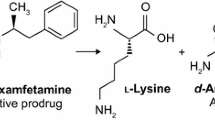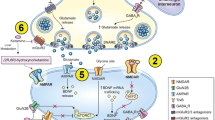Summary
Plasma levels of S-(+)-rolipram and R-(−)-rolipram in six healthy male volunteers were measured by radioimmunoassay after intravenous injection of 0.1 mg and oral administration of 1.0 mg of the pure enantionmers. Following i.v. treatment, plasma levels of both isomers declined in three phases, with half-lives of 0.2 h, 0.6–0.9 h and 6–8 h. Total clearance was 6 ml · min−1 · kg−1. Oral administration of 1.0 mg gave a peak concentration of 16 ng · ml−1 after 0.5 h. Bioavailability of (+)-rolipram was 77% and of the (−) enantiomer it was 74%. There was no significant difference in Cmax, half-life, total clearance or bioavailability between the two enantiomers.
Similar content being viewed by others
References
Wachtel H (1982) Characteristic behavioural alteration in rats induced by rolipram and other selective adenosine cyclic 3′, 5′-monophosphate phosphodiesterase inhibitors. Psychopharmacology 77: 309–316
Wachtel H (1983) Potential antidepressant activity of rolipram and other selective cyclic adenosine 3′, 5′-monophosphate phosphodiesterase inhibitors. Neuropsychopharmacology 22: 267–272
Horowski R, Sastre M (1985) Clinical effects of the neurotropic selective cAMP phosphodiesterase inhibitor rolipram in depressed patients: Global evaluation of the preliminary reports. Current Ther Res 38: 23–29
Zeller E, Stief HJ, Pflug B, Sastre-y-Hernandez M (1984) Results of a phase II study of the antidepressant effect of rolipram. Pharmacopsychiatry 17: 188–190
Przegalinski E, Bigajska K, Lewandowska A (1981) The influence of rolipram in the central serotoninergic system. Pharmacopsychiatry 14: 162–166
Schultz JE, Schmidt BH (1986) Rolipram, a stereospecific inhibitor of calmodulin-independent phosphodiesterase, causes β-adrenoceptor subsensitivity in rat cerebral cortex. Naunyn-Schmiedeberg's Arch Pharmacol 333: 23–30
Krause W, Kühne G (1988) Pharmacokinetics of rolipram in the rhesus and cynomolgus monkeys, the rat and the rabbit. Studies on species differences. Xenobiotica 18: 561–571
Pfeffer M, Sauerbrey N, Windt-Hanke F, Krause W. In-vitro-and-in a human pharmacokinetic study -in-vivo characterisation of two retard formulations for the antidepressant rolipram. Arzneimittelforschung (in press)
Krause W, Kühne G, Matthes H (1989) Pharmacokinetics of the antidepressant rolipram in healthy volunteers. Xenobiotica, 19: 683–692
Drayer DE (1986) Pharmacodynamic and pharmaceokinetic differences between drug enantiomers in humans: an overview. Clin Pharmacol Ther 40: 125–131
Hubbard JW, Ganes D, Lim HK, Midha KK (1986) Clinical pharmacology and its consequences for therapeutic monitoring. Clin Biochem 19: 107–112
Ariens EJ (1984) Stereochemistry, a basis for sophisticated nonsense in pharmacokinetics and clinical pharmacology. Eur J Clin Pharmacol 26: 663–668
Simonyi M (1984) On chiral drug action. Med Res Rev 4: 359–413
Brittain RT, Drew GM, Levy GP (1982) The α-and β-adrenoceptor blocking potencies of labetalol and its individual stereoisomers in anaesthetized dogs and in isolated tissues. Br J Pharmacol 77: 105–114
Elliott HL, Meredith PA, Sumner DJ, Reid JL (1984) Comparison of the clinical pharmacokinetics and concentration-effect relationship for medroxalol and labetalol. Br J Clin Pharmacol 17: 573–578
Cheng HC, Rearis OK jr, Grisar JM, Claxton GP, Weiner DL, Woodward JK (1980) Antihypertensive and adrenergic receptor blocking properties of the enantiomers of medroxalol. Life Sci 27: 2529–2534
Blaschke G, Kraft HP, Fickenscher K, Kohler F (1979) Chromatographische Racemattrennung von Thalidomid und teratogene Wirkung der Enantiomere. Arzneimittelforschung 29: 1640–1642
Olanoff LS, Walle T, Walle UK, Cowart TD, Gaffney TE (1984) Stereoselective clearance and disposition of intravenous propranolol. Clin Pharmacol Ther 35: 755–761
Walle T, Walle UK, Wilson MJ, Fagan TC, Gaffney TE (1984) Stereoselective ring oxidation of propranolol in man. Br J Clin Pharmacol 18: 741–747
Bowman WC, Rand MJ (1980) Textbook of Pharmacology, 2nd ed. Blackwell, Oxford
Eichelbaum M, Mikus G, Vogelsang B (1984) Pharmacokinetics of (+), (−), and (±)-verapamil after intravenous administration. Br J Clin Pharmacol 17: 453–458
Ho JK, Harris RA (1981) Mechanism of action of barbiturates. Ann Rev Pharmacol Toxicol 21: 83–111
McGraw NP, Callery PS, Castagnoli N jr (1977) In vitro stereo-selective metabolism of psychotromimetic amine 1-(2,5-dimethoxy-4-methylphenyl)-2-aminopropane. An apparent enantiomeric interaction. J Med Chem 20: 185–189
Ariens EJ, Mohr K (1985) Stereochemische Irrwege in der Pharmakotherapie. Dtsch Med Wochenschr 110: 1741–1749
Author information
Authors and Affiliations
Rights and permissions
About this article
Cite this article
Krause, W., Kühne, G. & Sauerbrey, N. Pharmacokinetics of (+)-rolipram and (−)-rolipram in healthy volunteers. Eur J Clin Pharmacol 38, 71–75 (1990). https://doi.org/10.1007/BF00314807
Received:
Accepted:
Issue Date:
DOI: https://doi.org/10.1007/BF00314807




